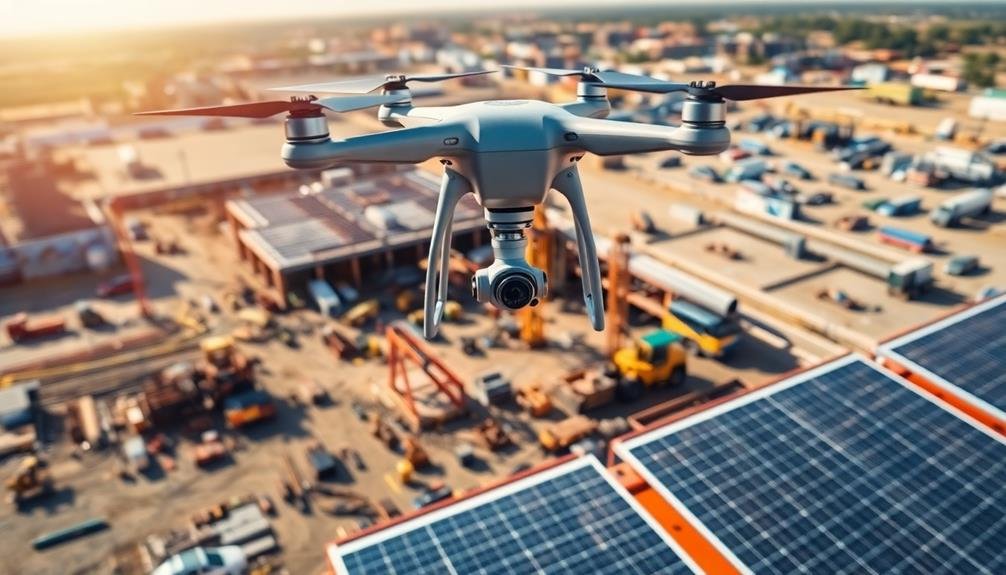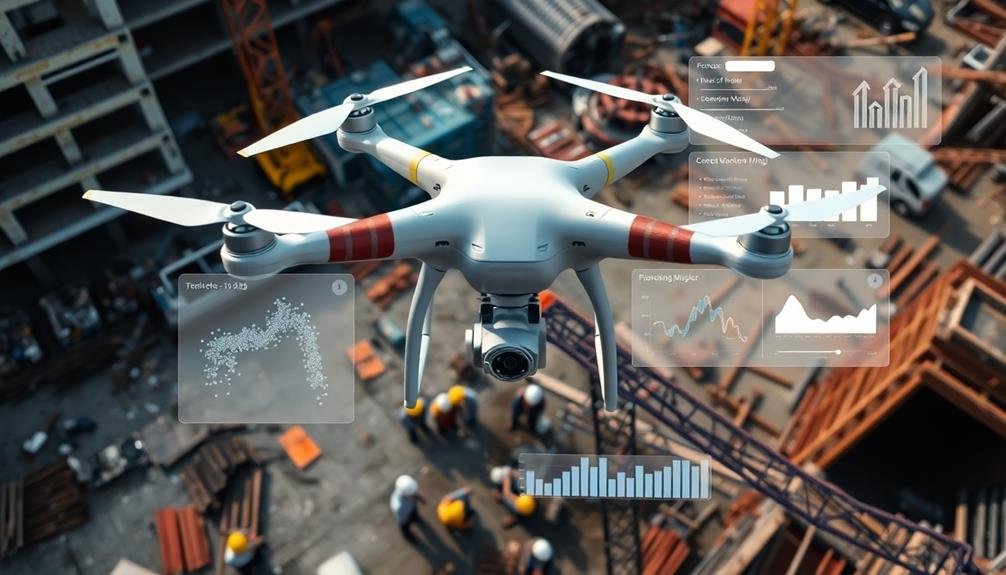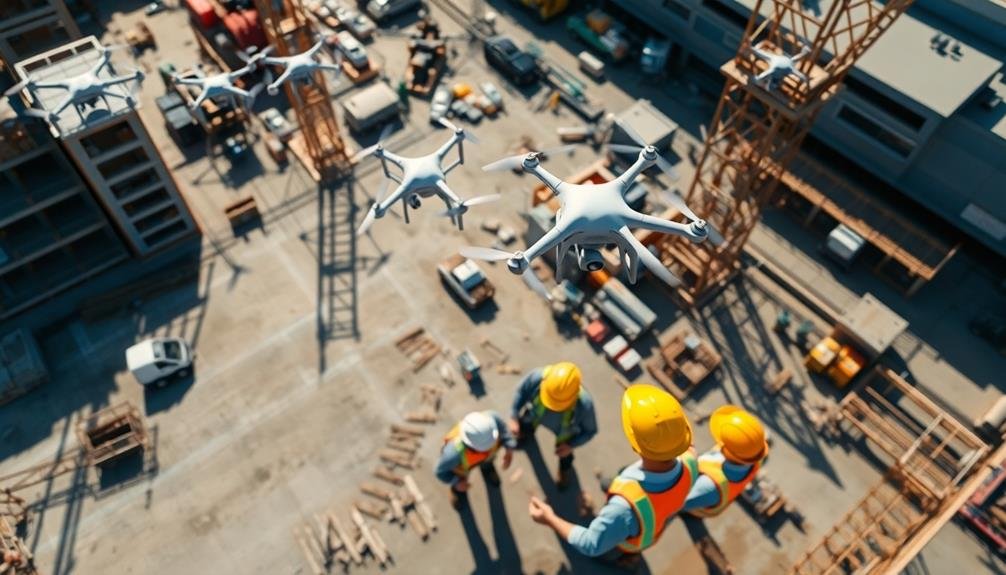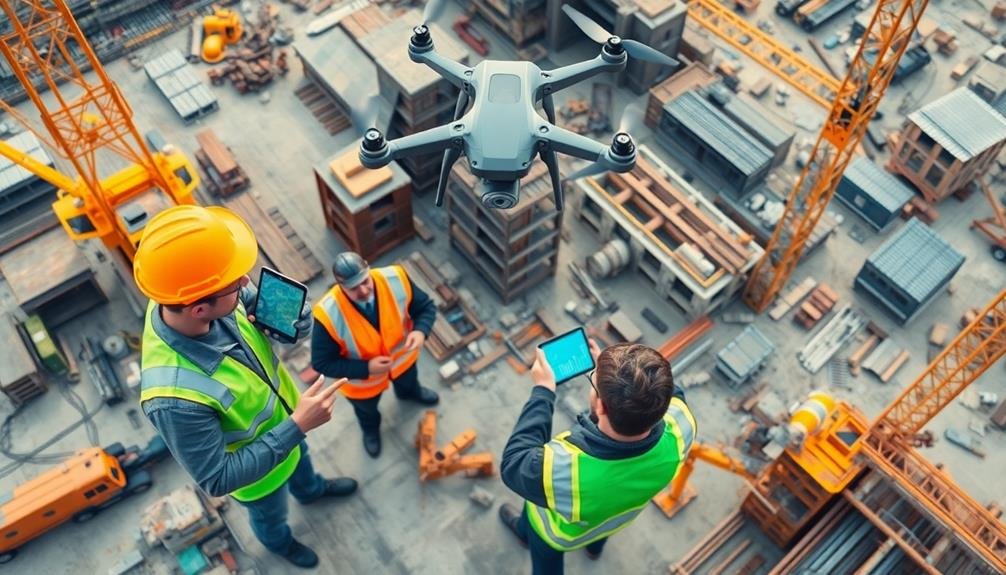Real-time construction monitoring with drones and IoT sensors gives you a bird's-eye view of your project sites. You'll get instant access to high-resolution images, videos, and sensor data, allowing for swift decision-making and improved safety measures. These "flying eyes" conduct faster, more accurate site surveys and create detailed 3D models for better planning. They'll help you optimize resource allocation, track progress, and guarantee regulatory compliance. With real-time alerts, you can address issues before they escalate, potentially saving time and money. This technology is transforming project management, offering unparalleled oversight and control. Discover how this cutting-edge approach can revolutionize your construction projects.
Drone Technology in Construction

Drones have soared to the forefront of construction monitoring, revolutionizing how project managers oversee work sites. These unmanned aerial vehicles provide a bird's-eye view of your entire project, capturing high-resolution images and videos in real-time.
You'll gain instant access to thorough visual data, allowing you to track progress, identify potential issues, and make informed decisions quickly.
With drone technology, you can conduct site surveys faster and more accurately than traditional methods. You'll save time and resources while reducing safety risks associated with manual inspections.
Drones equipped with thermal cameras can detect heat signatures, helping you identify energy inefficiencies or potential fire hazards.
You can use drones to create detailed 3D models of your construction site, enabling better planning and design adjustments.
They're also excellent for monitoring material stockpiles, ensuring you always have an accurate inventory.
Benefits of Aerial Monitoring

A bird's-eye perspective offers unparalleled advantages in construction monitoring. You'll gain a thorough view of your entire project site, allowing you to spot potential issues and track progress more effectively than ground-level observations alone.
Aerial monitoring provides real-time data on site conditions, enabling you to make informed decisions quickly. You can easily assess logistics, material placement, and equipment positioning, optimizing workflow and resource allocation. It's also an excellent tool for identifying safety hazards that mightn't be visible from the ground.
With aerial imagery, you'll create accurate, up-to-date site maps and 3D models. These visuals are invaluable for project planning, stakeholder communication, and documentation. You can track earthwork volumes, measure stockpiles, and monitor environmental impact with greater precision.
Aerial monitoring also enhances security by providing a clear overview of site boundaries and detecting unauthorized access. It's an effective way to document site conditions for insurance purposes and dispute resolution.
Data Collection and Analysis

While aerial monitoring provides a thorough view, the real power lies in the data it generates. You'll receive a wealth of information that can be analyzed to improve project efficiency and decision-making. Drones equipped with high-resolution cameras and sensors collect data on site progress, material usage, and potential safety hazards.
This raw data is then processed using advanced software that can identify patterns, anomalies, and trends. You'll get access to detailed reports, 3D models, and time-lapse videos that offer insights into your project's status. Here's a breakdown of the data collection and analysis process:
| Step | Description |
|---|---|
| 1. Capture | Drones fly predetermined routes, capturing images and sensor data |
| 2. Upload | Collected data is uploaded to cloud servers for processing |
| 3. Process | AI algorithms analyze the data, generating reports and models |
| 4. Review | You access the processed information through user-friendly dashboards |
Safety Improvements on Site

Revolutionizing safety protocols, real-time construction monitoring considerably reduces on-site risks.
You'll see immediate improvements in hazard identification and prevention. Drones and IoT sensors constantly scan your site, alerting you to potential dangers before they escalate. You can quickly address issues like unstable scaffolding, unsecured equipment, or workers in restricted areas.
Real-time monitoring enhances your ability to enforce personal protective equipment (PPE) compliance.
You'll receive instant notifications if workers aren't wearing hardhats, safety vests, or other required gear. This system also helps you manage site access more effectively, ensuring only authorized personnel enter hazardous zones.
You'll benefit from improved emergency response times.
In case of an accident, you can quickly locate affected workers and guide first responders to their exact position. The system's historical data allows you to analyze patterns and trends, helping you refine your safety strategies over time.
Cost-Effective Project Management

Real-time construction monitoring can greatly reduce your need for on-site personnel, leading to substantial cost savings.
You'll be able to oversee multiple projects simultaneously with fewer staff members, optimizing your workforce efficiency.
This technology also enables you to streamline resource allocation, ensuring materials and equipment are used effectively and minimizing waste.
Reduced On-Site Personnel
Real-time construction monitoring's ability to reduce on-site personnel is a game-changer for cost-effective project management. You'll find that by implementing this technology, you can notably decrease the number of staff required on-site. This reduction translates to lower labor costs, fewer safety risks, and improved overall efficiency.
With real-time monitoring systems in place, you can remotely oversee multiple aspects of your construction project. You'll have eyes on material deliveries, equipment usage, and work progress without physically being present. This means you can allocate your human resources more strategically, assigning personnel only where they're absolutely necessary.
You'll also benefit from reduced travel expenses and time savings. Instead of sending supervisors to various sites, they can monitor multiple projects from a central location. This not only cuts down on transportation costs but also allows for quicker decision-making and problem-solving.
Moreover, you'll minimize the need for constant on-site inspections. Automated systems can alert you to potential issues, allowing you to dispatch personnel only when required. This targeted approach guarantees that your workforce is utilized efficiently, contributing to a leaner, more cost-effective project management strategy.
Streamlined Resource Allocation
Streamlined resource allocation stands as a cornerstone of cost-effective project management in construction. With real-time monitoring, you'll enhance your resource distribution, ensuring materials, equipment, and labor are utilized efficiently. By analyzing drone footage and data, you can identify bottlenecks, idle resources, and areas requiring immediate attention.
You'll make informed decisions about resource deployment, minimizing waste and maximizing productivity. Real-time insights enable you to adjust schedules, reassign workers, and reallocate equipment on the fly. This agility leads to significant cost savings and improved project timelines.
Here's how real-time monitoring impacts resource allocation:
| Resource Type | Benefits | Cost Savings |
|---|---|---|
| Materials | Precise inventory management | Reduced overordering |
| Equipment | Ideal utilization | Lower idle time costs |
| Labor | Efficient task assignment | Decreased overtime expenses |
| Time | Proactive problem-solving | Fewer project delays |
Real-Time Decision Making

The backbone of effective project management lies in making informed decisions swiftly. With real-time construction monitoring, you're empowered to do just that. As data streams in from your drones and sensors, you'll have access to up-to-the-minute information on every aspect of your project.
You can quickly identify potential issues before they escalate into major problems. Spot a delay in material delivery? You'll know immediately and can adjust your schedule or find alternative suppliers.
Notice unexpected weather patterns affecting your site? You can proactively modify your work plans to minimize disruptions.
Real-time decision making also enhances safety. If you detect unsafe conditions or practices, you can intervene immediately, potentially preventing accidents.
You'll also be able to optimize resource allocation on the fly, redirecting workers and equipment where they're needed most.
This dynamic approach to project management allows you to stay ahead of the curve. Instead of reacting to problems after they occur, you're anticipating and addressing challenges proactively.
The result? Smoother operations, improved efficiency, and a higher likelihood of completing your project on time and within budget.
Environmental Impact Assessment

Beyond traditional project metrics, real-time construction monitoring offers powerful tools for evaluating environmental impact. You can now assess and mitigate your project's ecological footprint more effectively than ever before.
With drones and IoT sensors, you'll gather real-time data on air quality, noise levels, and water runoff. This continuous stream of information allows you to quickly identify and address potential environmental issues.
You'll monitor dust particles, tracking their spread and concentration to guarantee compliance with air quality regulations. Noise sensors will help you manage sound pollution, alerting you when levels exceed permitted thresholds. Water quality monitors will detect contamination in nearby water bodies, enabling swift corrective action.
Real-time monitoring also supports wildlife protection efforts. You can use thermal cameras to detect animal activity near your site, helping you avoid disturbing local ecosystems.
By analyzing vegetation health through multispectral imaging, you'll minimize damage to surrounding flora. This extensive environmental data empowers you to make informed decisions, reducing your project's ecological impact.
You'll demonstrate responsible construction practices, potentially improving public perception and regulatory compliance. Ultimately, real-time environmental monitoring helps you build sustainably and ethically.
Regulatory Compliance and Permissions

Real-time construction monitoring revolutionizes regulatory compliance and permissions processes. You'll find that using drones and advanced sensors allows for continuous tracking of your project's adherence to local, state, and federal regulations. This technology enables you to quickly identify and address potential violations before they become costly issues.
You can now efficiently document and report on key compliance metrics, such as noise levels, dust control, and site safety measures. With real-time data at your fingertips, you're better equipped to handle surprise inspections and demonstrate your commitment to regulatory standards.
When it comes to obtaining and maintaining necessary permits, real-time monitoring proves invaluable. You can easily provide up-to-date information on project progress, environmental impact, and safety measures to relevant authorities. This transparency often streamlines the approval process and helps maintain positive relationships with regulatory bodies.
Moreover, you'll find that real-time monitoring aids in self-policing efforts. By continuously tracking your project's compliance, you can proactively address any deviations from approved plans or permits, reducing the risk of fines or work stoppages.
This proactive approach not only guarantees regulatory compliance but also enhances your project's overall efficiency and reputation.
Future of Construction Monitoring

Looking ahead, future construction monitoring technologies promise to revolutionize the industry even further. You'll see advancements in artificial intelligence and machine learning algorithms that can predict potential issues before they occur. These systems will analyze vast amounts of data from multiple sources, offering proactive solutions to keep your projects on track.
Expect to see more integration of augmented reality (AR) and virtual reality (VR) in construction monitoring. You'll be able to visualize project progress in real-time, comparing it to digital models and spotting discrepancies instantly.
Wearable tech will become commonplace, with smart helmets and vests providing real-time data on worker safety and productivity.
The Internet of Things (IoT) will play a larger role, with sensors embedded in building materials and equipment. You'll have access to continuous data on structural integrity, environmental conditions, and equipment performance.
Blockchain technology will enhance data security and transparency, ensuring all stakeholders have access to reliable, tamper-proof information.
As 5G networks become ubiquitous, you'll experience faster, more reliable data transmission, enabling real-time decision-making across your construction sites.
These advancements will lead to safer, more efficient, and more sustainable construction practices.
Frequently Asked Questions
How Often Should Drone Flights Be Conducted for Effective Construction Monitoring?
You should conduct drone flights weekly for effective construction monitoring. However, adjust frequency based on project size, complexity, and stage. Daily flights may be necessary during critical phases, while monthly flights might suffice for slower periods.
Can Drones Operate Effectively in All Weather Conditions for Construction Monitoring?
You'll find drones can't operate in all weather conditions. They're limited by strong winds, heavy rain, and extreme temperatures. You'll need to plan flights on clear days for best results in construction monitoring.
What Specific Training Is Required for Drone Operators in Construction Projects?
You'll need FAA certification, drone piloting skills, and construction knowledge. It's essential to learn safety protocols, local regulations, and site-specific procedures. Familiarize yourself with the project's goals and how to interpret aerial data effectively.
How Are Privacy Concerns Addressed When Using Drones for Construction Monitoring?
You'll need to address privacy concerns by notifying nearby residents, limiting flight paths, blurring sensitive areas in footage, and securing data. It's essential to follow local regulations and obtain necessary permits for drone operations.
Can Drone-Collected Data Be Integrated With Existing Construction Management Software Systems?
Yes, you can integrate drone-collected data with your existing construction management software. Many systems now offer APIs or plugins that allow seamless integration, enabling you to incorporate aerial imagery, 3D models, and progress reports directly into your workflow.
In Summary
You've seen how real-time construction monitoring with drones is revolutionizing the industry. It's enhancing safety, improving efficiency, and providing valuable data for decision-making. As you embrace this technology, you'll find it's a game-changer for project management and environmental assessment. Remember to stay updated on regulations and permissions. The future of construction monitoring is here, and it's flying high. Don't get left behind – start incorporating drone technology into your projects today.

As educators and advocates for responsible drone use, we’re committed to sharing our knowledge and expertise with aspiring aerial photographers.




Leave a Reply